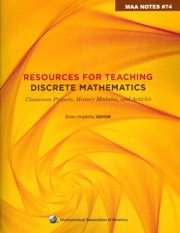Book contents
- Frontmatter
- Introduction
- Dedication
- Contents
- I Classroom-tested Projects
- The Game of “Take Away”
- Pile Splitting Problem: Introducing Strong Induction
- Generalizing Pascal: The Euler Triangles
- Coloring and Counting Rectangles on the Board
- Fun and Games with Squares and Planes
- Exploring Recursion with the Josephus Problem: (Or how to play “One Potato, Two Potato” for keeps)
- Using Trains to Model Recurrence Relations
- Codon Classes
- How to change coins, M&M's, or chicken nuggets: The linear Diophantine problem of Frobenius
- Calculator Activities for a Discrete Mathematics Course
- Bulgarian solitaire
- Can you make the geodesic dome?
- Exploring Polyhedra and Discovering Euler's Formula
- Further Explorations with the Towers of Hanoi
- The Two Color Theorem
- Counting Perfect Matchings and Benzenoids
- Exploring Data Compression via Binary Trees
- A Problem in Typography
- Graph Complexity
- II Historical Projects in Discrete Mathematics and Computer Science
- III Articles Extending Discrete Mathematics Content
- IV Articles on Discrete Mathematics Pedagogy
- About the Editor
Further Explorations with the Towers of Hanoi
from I - Classroom-tested Projects
- Frontmatter
- Introduction
- Dedication
- Contents
- I Classroom-tested Projects
- The Game of “Take Away”
- Pile Splitting Problem: Introducing Strong Induction
- Generalizing Pascal: The Euler Triangles
- Coloring and Counting Rectangles on the Board
- Fun and Games with Squares and Planes
- Exploring Recursion with the Josephus Problem: (Or how to play “One Potato, Two Potato” for keeps)
- Using Trains to Model Recurrence Relations
- Codon Classes
- How to change coins, M&M's, or chicken nuggets: The linear Diophantine problem of Frobenius
- Calculator Activities for a Discrete Mathematics Course
- Bulgarian solitaire
- Can you make the geodesic dome?
- Exploring Polyhedra and Discovering Euler's Formula
- Further Explorations with the Towers of Hanoi
- The Two Color Theorem
- Counting Perfect Matchings and Benzenoids
- Exploring Data Compression via Binary Trees
- A Problem in Typography
- Graph Complexity
- II Historical Projects in Discrete Mathematics and Computer Science
- III Articles Extending Discrete Mathematics Content
- IV Articles on Discrete Mathematics Pedagogy
- About the Editor
Summary
Summary
This project is a supplement to the usual introduction to the Towers of Hanoi problems that appear in most discrete mathematics texts. Many concepts from discrete mathematics are discussed, including Hamiltonian paths, representation of integers in other bases, graph theory, and number theory.
Notes for the instructor
Puzzles are a great way to pass time. However, they can also be an excellent source for mathematical applications. There are few puzzles more famous than the Towers of Hanoi. The point of this project is not to teach the students how to solve the puzzle, nor is it designed to teach a formula for the minimum number of moves required to solve the puzzle. In fact, it is highly probable that you have already discussed these things with your class. Instead, the purpose of this project is to tie together many of the topics that you have taught in your discrete mathematics course.
If you have not already done so, introduce the students to the Towers of Hanoi in your textbook. If your textbook does not discuss the puzzle, write to the author and demand that it be included in the next edition of the book and then find a reference on how to solve the puzzle on the Internet. Students will be ready when they know how to solve the puzzle and a formula for the minimum number of moves required to solve a puzzle with n disks.
- Type
- Chapter
- Information
- Resources for Teaching Discrete MathematicsClassroom Projects, History Modules, and Articles, pp. 117 - 124Publisher: Mathematical Association of AmericaPrint publication year: 2009

